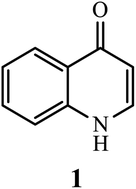Recent advances in the synthesis of pharmaceutically active 4-quinolone and its analogues: a review
Abstract
4-Quinolone and its analogs are heterocyclic classes of organic compounds displaying biologically active and a broad spectrum of pharmaceutical drug scaffolds. 4-Quinolone is the first-line chemotherapeutic treatment for a wide spectrum of bacterial infections. Recently, 4-quinolone and its derivatives have been shown to have the potential to cure and regulate various acute and chronic diseases, including pain, ischemia, immunomodulation, inflammation, malarial, bacterial infection, fungal infection, HIV, and cancer, based on several reports. This review highlights and provides brief information to better understand the development of experimental progress made to date in the synthetic protocol towards 4-quinolone and its analogs. Thus, classical synthesis protocol, metal-free reaction protocol, and transition metal-catalyzed reaction procedures are briefly discussed along with the pharmaceutical activities of selected 4-quinolone derivatives.

- This article is part of the themed collection: 2022 Reviews in RSC Advances


 Please wait while we load your content...
Please wait while we load your content...